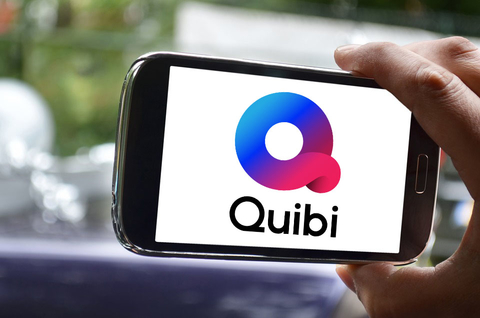Can Quibi Build a Brand From Scratch Amid Stiff Streaming Competition?
Everything you need to know about Jeffrey Katzenberg’s well-backed, star-studded and competitively challenged mobile-first video platform

With a flurry of five short commercials during the Oscars telecast, Quibi kicked off the ad blitz it needs to teach potential subscribers such basics as how to pronounce the company’s name (say “kwih-bee”), and why they might use the mobile streaming-video service in the first place.
The ad blitz was also a metaphor for Quibi itself and the challenges it faces launching a new entertainment brand, built entirely around short-form mobile video consumption, into the brutally competitive online-streaming sector.
On Oscar night, the brief ads made the point that even when time is tight, you can still watch all of a Quibi episode. Its series—Quibi plans 175 of them, and 8,500 pieces of content in its first year—will unfold in seven- to 10-minute bites over multiple weeks. Ads wrapped around Quibi episodes will be short too, from 6- to 15-seconds long. For access to all that, subscribers will pay about $5 a month for an ad-supported version of Quibi, and $8 per month for an ad-free version.
Also Read: CES 2020: Quibi Looks for More Successful Drive While Going 90
The Quibi Oscar ads invoked a range of genres–-from animation to a zombie infestation to an explorer stuck in quicksand. Similarly, Quibi’s content will include all kinds of scripted genres, as well as game shows, reality competitions and more.
The Quibi ads were pricey, punchy, and well produced. Ad Age reported that ABC charged up to $2.8 million for 30-second Oscar ads. Throw in Quibi’s $5.6 million Super Bowl commercial from a week earlier, and Quibi is well on the way to spending down that $470 million the company said it would invest on launch marketing.
Quibi founder Jeffrey Katzenberg and CEO Meg Whitman also are paying big money to creative talent, up to $100,000 per minute for what are feature-length stories diced into short pieces. Even better, Quibi creators get back rights to the full-length version of their show in two years, and the episodic version in seven years.
NEXT TV NEWSLETTER
The smarter way to stay on top of the streaming and OTT industry. Sign up below.
The Quibi Oscar blitz was a useful metaphor in another way, too. Despite the plethora of ads, Quibi needed just about all of them to get its message across amid all the other brands, especially the many Disney-owned networks that also ran commercials.
Those networks included Hulu, National Geographic, Freeform, ABC and its local affiliate, and of course, just-launched Disney Plus. Quibi launches into a streaming universe that already includes as many as 300 services, with at least two more big ones launching soon after Quibi’s April 6 debut: Comcast’s Peacock and AT&T’s HBO Max.
Innovation
Quibi is trying to create a unique approach to entertainment, focused on mobile, short-form, episodic video displayed through an innovative Turnstyle interface that fills your phone’s screen with an image whether you watch in portrait or landscape mode.
That dual approach, by the way, can double post-production costs, editors on several Quibi projects said, because each scene must be reframed and cut for the different aspect ratios. More worrisome, when Katzenberg and Whitman appeared at the Sundance Film Festival a few weeks back, the Quibi interface still wasn’t locked down, about two months from launch.
This Turnstyle technology is already the subject of patent infringement litigation, with a New York-based video technology company claiming in a California federal court that it developed the tech that lets users quickly transition from profile to landscape viewing modes, and back.
In May, Quibi lawyers testified that the company would face "immense harm" if it were to have to "rip out" its core Turnstyle feature. Two months later, though, a few weeks after denying plaintiff tech company Eko an injunction in its patent infringement battle with Quibi, a federal judge ruled that the suit's core complaint's can proceed.
Quibi's Challenge
In any era, Quibi’s challenge would be substantial: Building an entertainment brand around a largely untested medium, user interface and business model. The company has no library of proven shows, yet hopes to shift customer viewing habits so they will pay for unknown content featuring prominent talent.
Katzenberg and Whitman have raised a prodigious amount of money for Quibi, $1.75 billion since its 2018 introduction, from an admirable investor list that includes just about every studio in Hollywood.
Quibi has also enlisted a remarkable and broad list of creators, from Katzenberg’s former DreamWorks co-founder Steven Spielberg, to Kiefer Sutherland, Liam Hemsworth, Christoph Waltz, Idris Elba, Andy Garcia, Antoine Fuqua, Will Forte, Lena Waithe, and plenty of others.
But Quibi arrives just as a bunch of big companies, including some of their own investors, are also trying to make a splash with their own services. And Quibi’s biggest competitor for user attention is probably YouTube, which generates $15 billion a year in ad revenue, and is backed by a trillion-dollar company, pays nothing for most of its content, and is free to users.
As further evidence of the formidable challenge Quibi faces just from YouTube, App Annie released a study showing that even among the world’s five biggest mobile-video apps, YouTube vacuums up 70 percent of time spent. Most of the top 10 mobile video services are based in China and India, including Tencent News, Tencent Video, IQIYI, Xigua Video, Youku, Baidu Haokan, MXPlayer, and Hotstar. Netflix is sixth on App Annie’s list.
"YouTube has a hybrid offering of long- and short-form content, as opposed to a service like TikTok (one-minute maximum) or Netflix (30- to 60-minute episodes and 60+-minute movies),” the App Annie report says. "This wider breadth of content helps better suit consumers’ viewing habits: there’s something for you regardless of how much time and attention you have available."
App Annie, which tracks usage of mobile apps, projects that “our smartphones are set to be battleground for consumer mindshare and ad dollars,” with a projected $240 billion to be spent on mobile advertising this year, up 25 percent. Quibi’s premium approach is betting that it can persuade some of YouTube’s sea of users to pay with more than their attention to get better quality content from big-name talent.
In the first several weeks of its launch, various app services tracked middling download performance, and reviews have been generally poor. Barclays media analyst Kannan Venkateshwar has called the service "an old-media mindset squeezed into a new-media form factor without any purpose."
If that weren’t enough for Quibi, there’s even Ficto, a free ad-supported mobile video service that has been running in beta for months. Instead of paying creators substantial up-front funding, Ficto offers a blockchain-based system to track and pay out royalties based on audience views, said CEO Mike Esola.
For Quibi, Ficto is just another in a long list of competitors for audience attention and dollars. Quibi’s best hope may be that, like on Oscar night, its blizzard of short content can find an audience willing to watch, and pay for, what it has to say.
David Bloom of Words & Deeds Media is a Santa Monica, Calif.-based writer, podcaster, and consultant focused on the transformative collision of technology, media and entertainment. Bloom is a senior contributor to numerous publications, and producer/host of the Bloom in Tech podcast. He has taught digital media at USC School of Cinematic Arts, and guest lectures regularly at numerous other universities. Bloom formerly worked for Variety, Deadline, Red Herring, and the Los Angeles Daily News, among other publications; was VP of corporate communications at MGM; and was associate dean and chief communications officer at the USC Marshall School of Business. Bloom graduated with honors from the University of Missouri School of Journalism.

